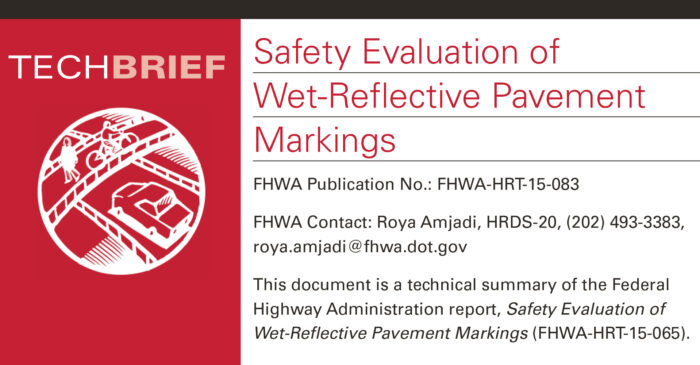
Wet Pavement Markings
Safety Effects of Wet-Weather Pavement Markings – Accident Analysis & Prevention, Volume 133, 2019, Eun Sug Park, Paul J. Carlson, Adam Pike. December 2019.
Safety Evaluation of Wet-Reflective Pavement Markings – U.S. DOT, Federal Highway Administration, Publication number: FHWA-HRT-15-065
Wet Retroreflectivity for Road Safety, A Comprehensive Analysis of Crash Reduction through Enhancing Visibility and Safety in Adverse Weather Conditions – presented at ATSSA Midyear Meeting, Aug. 2024, Louisville, Ky.
Standard Test Method for Measurement of Retroreflective Pavement Marking Materials with CEN-Prescribed Geometry Using a Portable Retroreflectometer – ASTM International E1710-18
Standard Test Method for Measuring the Coefficient of Retroreflected Luminance of Pavement Markings using the Bucket Method in a Condition of Wet Recovery – ASTM International E2177
Standard Test Method for Measuring the Coefficient of Retroreflected Luminance of Pavement Markings in a Standard Condition of Continuous Wetting (RL-2) – ASTM E2832-12 (2017) (Continuous wetting)
FHWA Safety Evaluation of Wet-Reflective Pavement Markings – 2015 FHWA-HRT-15-083.
Safety Evaluation of Wet-Reflective Pavement Markings (FHWA-HRT-15-065). Craig Lyon, Bhagwant Persaud, and Kimberly Eccles.
Additional Resources
Seeing the Road in Low-Visibility Conditions – Texas Transportation Researcher
KARE television news: Minnesota DOT is working on a solution as it resurfaces roads over the next few years (featuring Neal Peterson).
Night Lights: How Retroreflectivity Works – This 10-minute FHWA-funded video on retroreflectivity dates back to 2001, but its message is still loud and clear. “Night Lights” describes how bright, reflective materials on roadways and traffic safety devices saves lives by improving the roadway for motorists and pedestrians in a variety of scenarios. The video takes the very technical issue of retroreflectivity and defines the process in easy-to-understand terms for those outside of the roadway safety industry.






